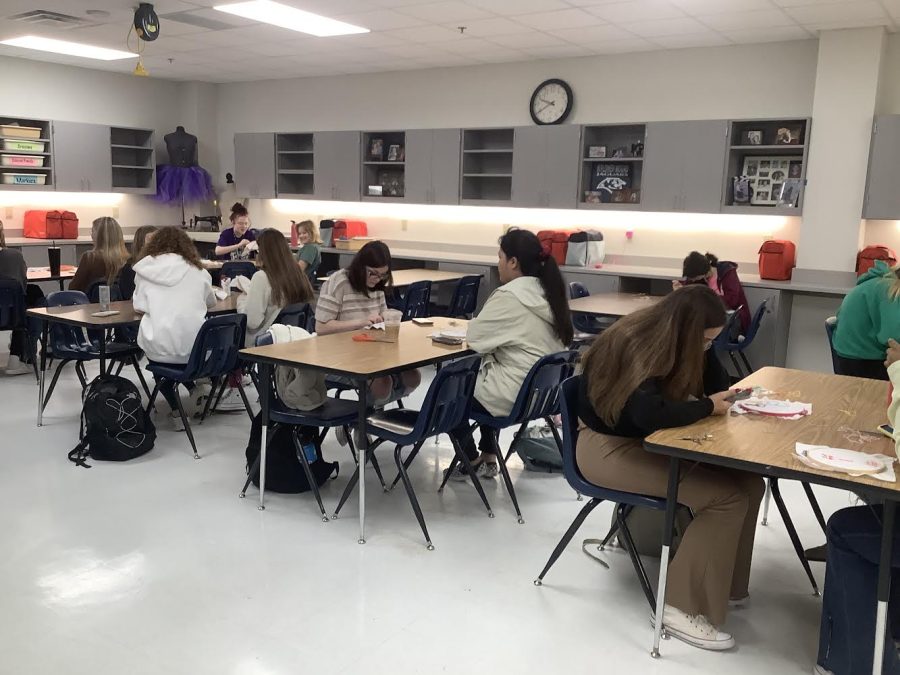Is Fashion Design Right For You?
Fashion Design Students are practicing their embroidery skills. They used this technique to add some designs to the tote bag they created earlier this semester. “The sewing is the best part because I feel like that’s something I can use in other parts of my life,” said Sandhu.
March 8, 2022
The halls are filled with posters advertising Fashion Design 2, but many students don’t know enough about the class itself. Fashion Design 1, formerly known as Apparel, has been a course since the school was founded, yet it has not gotten a consecutive course like many of the other electives. This does not stem from students’ lack of interest, but from their lack of knowledge about the course.
Mrs. Stagemeyer, the fashion design teacher, introduces a wide range of topics in Fashion Design 1. “We talk about different fashion designers, the elements of principles of design, fast fashion and its impacts on the environment and economy,” said Stagemeyer. The class also introduces students to new career choices and helps them explore their interests.
Naturally, Fashion Design 1 involves a lot of sketching and sewing. It may seem daunting, but luckily there are no prior skills necessary for this class. “If you can’t draw, if you can’t sew, that is totally fine. I will teach you everything you need to know. I’ve had kids that are expert sewers, and I’ve had kids who have never seen a sewing machine before. By the end of class, they are doing great,”. Stagemeyer said. Ranna Sandhu, a Fashion Design student, can attest to this. “Most of us in that class have zero sewing experience,” said Sandhu. “We are learning everything from scratch.”
Furthermore, the ability to sew is one of the most invaluable takeaways from this class since tailoring and alterations can cost up to $75. “If they need to sew a button onto their shirt or hem a pair of pants, they can do that. It will save them a lot of money in the future,” Stagemeyer stated.
After learning the basics of sewing, students start on their projects. “[The class has] learned how to sew a tote bag, and [they are] currently learning how to sew a zipper bag,” Sandhu said. These projects serve as an outlet for creativity and individuality. “[Students] get to pick [their] own projects and create something that [they’ll] actually use in the future,” Mrs. Stagemeyer stated. In addition to the sewing aspect, students learn about the latest fashions trends and the theories behind them. “We do one month of fashion learning and two weeks of sewing,” Sandhu said. For example, Sandhu described their next lesson topic: the “Trickle Down” theory. “It is basically the theory that the fashion you see in runways will slowly trickle down into modern and more public fashion.”
Regardless of the laid-back atmosphere in class, students are expected to take the class seriously. “It is a very fun elective, but I do expect you to learn and pay attention. We have days when we take notes,” Stagemeyer said. “It is not a blowoff class; there is work we have to get done, but it’s fun work, I think.”
Additionally, Fashion Design 1 gives students the opportunity to serve their community. “Both classes do some sort of community service project. In Fashion Design 1, we make these bears that we donate. In Fashion Design 2, [students] make baby blankets that are donated to a hospital for babies that are born to drug addicted mothers. [The blankets] usually go down to Parkland Hospital,” Mrs. Stagemeyer said. This is a great chance for students to see how their hard work can have a positive impact on their community.
All in all, Fashion Design teaches new life skills, service to your community, and creative expression. Stagemeyer is optimistic about the introduction of Fashion Design 2 where students will “delve more into fashion designers. [They] do screen printing — a technique to create custom shirts– and learn how to do a bunch of different designs on shirts. They can do more independent projects, where they can pick whatever they want. I really do hope that we get to have a Fashion Design 2 next semester.”


